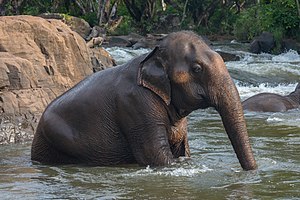Elephant

Elephants are the largest existing land animals. Three living species are currently recognised: the African bush elephant, the African forest elephant, and the Asian elephant. They are the only surviving members of the family Elephantidae and the order Proboscidea. The order was formerly much more diverse during the Pleistocene, but most species became extinct during the Late Pleistocene epoch. Distinctive features of elephants include a long proboscis called a trunk, tusks, large ear flaps, pillar-like legs, and tough but sensitive skin. The trunk is used for breathing and is prehensile, bringing food and water to the mouth, and grasping objects. Tusks, which are derived from the incisor teeth, serve both as weapons and as tools for moving objects and digging. The large ear flaps assist in maintaining a constant body temperature as well as in communication. African elephants have larger ears and concave backs, whereas Asian elephants have smaller ears, and convex or level backs.
Elephants are scattered throughout sub-Saharan Africa, South Asia, and Southeast Asia and are found in different habitats, including savannahs, forests, deserts, and marshes. They are herbivorous, and they stay near water when it is accessible. They are considered to be keystone species, due to their impact on their environments. Elephants have a fission–fusion society, in which multiple family groups come together to socialise. Females (cows) tend to live in family groups, which can consist of one female with her calves or several related females with offspring. The groups, which do not include bulls, are usually led by the oldest cow, known as the matriarch.
Males (bulls) leave their family groups when they reach puberty and may live alone or with other males. Adult bulls mostly interact with family groups when looking for a mate. They enter a state of increased testosterone and aggression known as musth, which helps them gain dominance over other males as well as reproductive success. Calves are the centre of attention in their family groups and rely on their mothers for as long as three years. Elephants can live up to 70 years in the wild. They communicate by touch, sight, smell, and sound; elephants use infrasound and seismic communication over long distances. Elephant intelligence has been compared with that of primates and cetaceans. They appear to have self-awareness, and appear to show empathy for dying and dead family members.
African bush elephants and Asian elephants are listed as endangered and African forest elephants as Critically Endangered by the International Union for Conservation of Nature (IUCN). One of the biggest threats to elephant populations is the ivory trade, as the animals are poached for their ivory tusks. Other threats to wild elephants include habitat destruction and conflicts with local people. Elephants are used as working animals in Asia. In the past, they were used in war; today, they are often controversially put on display in zoos, or exploited for entertainment in circuses. Elephants are highly recognisable and have been featured in art, folklore, religion, literature, and popular culture.
The effects of captivity on elephants

Elephants are known for their intelligence, social skills, and empathy towards other animals, including humans.[1] However, despite their unique qualities, elephants are often kept in captivity for various reasons, including tourism, entertainment, and religious purposes. There is a growing consensus that keeping elephants in captivity is wrong and has serious consequences for the animals' physical and emotional well-being.
Captivity denies elephants their natural habitat and social structure. In the wild, elephants are social animals that live in large herds and have strong familial bonds.[2] These herds travel long distances in search of food, water, and shelter. Captivity deprives elephants of their freedom to move and interact with their own kind. Elephants in captivity are often kept in confined spaces with limited mobility, which can lead to health problems such as arthritis, obesity, and foot disorders.[3]
Captivity also subjects elephants to physical and emotional abuse. Captivity often involves training elephants to perform unnatural behaviors, such as standing on their hind legs or balancing on balls, through the use of bullhooks. Elephants in captivity are also subjected to isolation, boredom, and stress, which can lead to the development of psychological disorders such as depression and anxiety.[4]
Captivity can also have negative consequences for the conservation of the species. The captivity of elephants encourages the belief that they are a commodity that can be used for human entertainment and profit, rather than as wild animals that need to be protected. This perception often leads to the illegal poaching and trade of elephants, which further endangers the species. Captivity fails to address the root causes of habitat loss and poaching that threaten the survival of elephants in the wild.[5]
See also
- The effects of captivity on elephants
- Elephant tourism
- List of living captive elephants
- Phajaan
- An Apology to Elephants - film
External links
- Elephant Wikipedia
- Elephas maximus Wikispecies
References
- ↑ Elephants are intelligent Elephant Voices
- ↑ Social Interactions in Zoo-Housed Elephants: Factors Affecting Social Relationships National Library of Medicine
- ↑ Health Problems & Disease Born Free
- ↑ The neural cruelty of captivity: Keeping large mammals in zoos and aquariums damages their brains AP News
- ↑ Critically endangered species should be left to breed in the wild Science Daily
